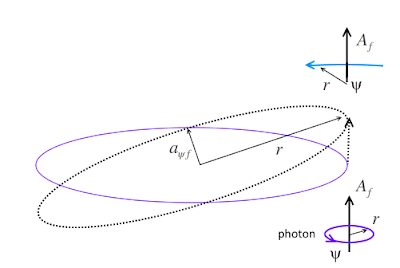where,
\(A_f=\sqrt{2}\sqrt{a^2_{\psi\,i}-a^2_{\psi\,f}}\) and
\(r^{ 2 }=2a^2_{\psi\,i}-a^2_{\psi\,f}\)
From the post "Touch And Go" dated 24 Dec 2014, transition to the state associated with \(a_{\psi\,i}\) occurs when the long radius of the ellipse equals \(a_{\psi\,i}\). This occurs before the perimeters of the initial and final states are equal.
\(A_f=\sqrt{a^2_{\psi\,i}-a^2_{\psi\,f}}\) and
\(r=a_{\psi\,i}\)
It could also be,
that the emission of a photon occurs only after \(\psi\) returns to \(a_{\psi\,f}\); after a timer interval \(t\), having traveled along the elliptical path a quarter of the way at light speed, \(c\). In this case, the emitted photon has a oscillatory component at \(a_{\psi\,f}\) only.
Which one of these occur? The emitted photon is at \(\sqrt{2a^2_{\psi\,i}-a^2_{\psi\,f}}\), \(a_{\psi\,i}\) or \(a_{\psi\,f}\). If there is a constraint on \(A_f\), below a threshold for which no emission occurs then all three possible scenarios can occur in different settings. All three photons at their respective energies \(E\) can be detected.
\(E=h.\cfrac{2\pi.a_{\psi}}{c}\)
What would be the constraint on \(A_f\)? Goodnight.


